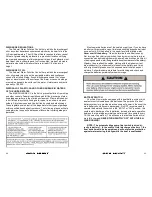
16
LOADING CAPACITY
Though overloading is a primary cause of many boating acci-
dents, improper loading is equally hazardous. Boaters should know
the amount of weight on board and evenly distribute the weight within
the boat. There is a capacity label affixed near the helm station of
your boat. Know your boat’s maximum capacity and don’t overload
the boat.
CARBON MONOXIDE
Exhaust fumes contain carbon monoxide (CO), an odorless and col-
orless gas. Carbon monoxide is poisonous and a health hazard that can
be fatal if breathed over an extended period of time. Symptoms of CO
poisoning can include: dizziness, nausea, headache, sleepiness, vomit-
ing, throbbing in temples, muscular twitching and the inability to think
clearly. If you or anyone else experience these symptoms immediately
get away from fumes and into an area with plenty of
FRESH
air. If symp-
toms persist seek medical attention.
The boat operator should be aware that CO is emitted from any boat’s
exhaust. You are susceptible to CO while operating, mooring, and or
anchoring in an area containing other boats emitting engine exhaust. An
operator, likewise, needs to be aware of the consequence of his actions
on other boats. Of primary concern is the operation of an auxiliary gen-
erator with boats moored along side each other.
When operating center console or dual console boats at cruising
speeds, slow speeds, or dead in the water with canvas tops, side cur-
tains and or back curtains in place, be aware of engine exhaust to en-
sure that emissions do not accumulate in the boats interior (the “station
wagon” effect). Maintain proper ventilation by adjusting the canvas enclo-
sure.
49
Store cushions and canvas indoors in a dry place to prevent mil-
dew.
Clean the exterior and interior of the boat
Remove all grease, oil, salt spray etc.
Remove all garbage. Clean the cabinets, lockers / storage, and
fish boxes and live wells.
The lids and doors should be propped open for ventilation
Empty toilet / head and flush with fresh water
Lubricate all hinges, valves, the backs of electrical panels and
other surfaces that may rust.
Check underwater items. Hardware should be in good condition
and tight. Inspect electrical systems and have any repairs per-
formed.
COMMISSIONING YOUR BOAT AFTER STORAGE
We want you to enjoy your boating experience and it is important
that you properly re-commission your Sea Hunt boat. Before placing
your boat in the water for the boating season, have the hull bottom
cleaned. Sand and reapply antifouling bottom paint, if necessary.
Leave as much equipment and personal effects off the boat until after
launch and final check.
PRIOR TO LAUNCHING
It is recommended that your Sea Hunt boat be re-commissioned by
an authorized dealer. Below is a list of items to check and perform
prior to placing your boat in the water. The following list will give you
some ideas and suggestions.
Check all gear and replace if necessary.
Check thru hull fittings for cleanliness, damage and tightness.
Check prop installation and tightness.
Clean battery terminal posts with a wire brush or bronze wool.
Install batteries, attach cables and tighten. Apply grease to post to
exclude air and acid. Check all wire connections for contact corro-
sion and tightness.
Check hull valves for easy operation and for condition of hose.
Check operation of bilge pumps in manual and automatic modes.
Check operation of all DC circuits.
















































